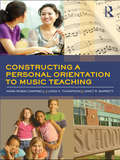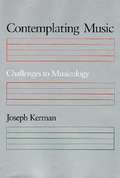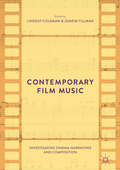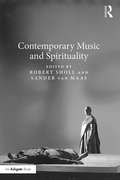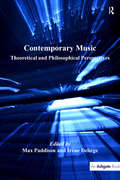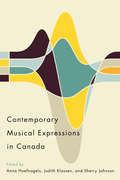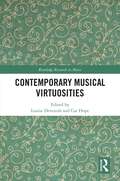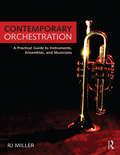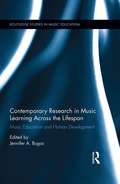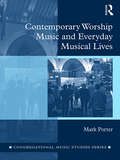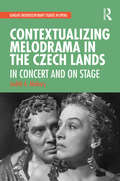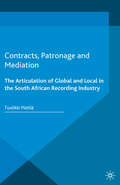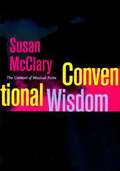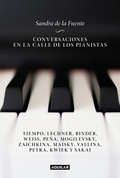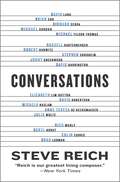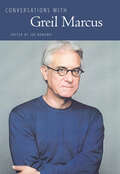- Table View
- List View
Constructing a Personal Orientation to Music Teaching
by Mark Robin Campbell Linda K Thompson Janet R. BarrettConstructing a Personal Orientation to Music Teaching promotes inquiry and reflection to facilitate teacher growth, lifelong learning and a disposition toward educational change. Strongly grounded in current theories and research in teacher education, the text engages readers in analyzing their own experiences in order to conceptualize the complexity of teaching; involves them in clarifying their reasons for seeking a career in teaching; supports their insights, questions, and reflections about their work; and promotes a reflective, critical attitude about schools in general as teachers are urged to think of themselves as change agents in school settings.
Constructing a Personal Orientation to Music Teaching: Growth, Inquiry, and Agency
by Mark Robin Campbell Linda K. Thompson Janet Revell BarrettConstructing a Personal Orientation to Music Teaching: Growth, Inquiry, and Agency, (Second Edition), is a textbook for studies in music education. Expanding upon the first edition, the authors promote inquiry and reflection to facilitate teacher growth, lifelong learning, and a disposition toward educational change. The revised text responds to current calls for social change and teacher education reform by reaffirming and intensifying the need for music teachers to adopt a personal orientation toward their work. A personal orientation encourages teachers to initiate their own growth, engage in inquiry, and exercise agency in school contexts. Strongly grounded in current theories and research in teacher education, Constructing a Personal Orientation to Music Teaching: Growth, Inquiry, and Agency strives to do the following: Engage readers in analyzing their own experiences in order to conceptualize the complexity of teaching Involve them in clarifying their reasons for seeking a career in teaching Support their insights, questions, and reflections about their work Promote a reflective, critical attitude about schools in general as music teachers are urged to think of themselves as change agents in school settings Construct a moral purpose as a compass to guide their current and future endeavors in the profession. Every chapter includes a wealth of pedagogical features, including new methodologies and examples of practice to engage the readers in processes of inquiry and reflection. The second edition is organized in two parts. Part I focuses on positioning music teachers as learners in the profession, significantly expanding concepts explored in the first edition that are central to a personal orientation to professional growth. In the new edition, a reconceptualized Chapter 5 challenges teachers to cultivate their identities as change agents. The second half of the book—focusing on becoming a student of music teaching— features five new chapters. A provocative chapter on curriculum sets the stage for a set of additional chapters that invite deeper considerations of the commonplaces of teacher, learners, subject matter, and context. An epilogue speaks directly to the power of agency, imagination, and hope in teachers’ lives.
Consuming Music in the Digital Age: Technologies, Roles and Everyday Life (Pop Music, Culture and Identity)
by Raphaël NowakThis book addresses the issue of music consumption in the digital era of technologies. It explores how individuals use music in the context of their everyday lives and how, in return, music acquires certain roles within everyday contexts and more broadly in their life narratives.
Contact High: A Visual History of Hip-Hop
by Questlove Vikki TobakAn inside look at the work of hip-hop photographers told through their most intimate diaries—their contact sheets. Featuring rare outtakes from over 100 photoshoots alongside interviews and essays from industry legends, Contact High: A Visual History of Hip-Hop takes readers on a chronological journey from old-school to alternative hip-hop and from analog to digital photography. The ultimate companion for music and photography enthusiasts, Contact High is the definitive history of hip-hop’s early days, celebrating the artists that shaped the iconic album covers, t-shirts and posters beloved by hip-hop fans today. With essays from BILL ADLER, RHEA L. COMBS, FAB 5 FREDDY, MICHAEL GONZALES, YOUNG GURU, DJ PREMIER, and RZA
Contemplating Music: Challenges to Musicology
by Joseph KermanContemplating Music is a book for all serious music lovers. Here is the first full-scale of ideas and ideologies in music over the past forty years; a period during which virtually every aspect of music was transformed. With this book, Joesph Kerman establishes the place of music study firmly in the mainstream of modern intellectual history. He treats not only the study of the history of Western art music--with which musicology is traditionally equated--but also sometimes vexed relations between music history and other fields: music theory and analysis, ethnomusicology, and music criticism. Kerman sees and applauds a change in the study of music toward a critical orientation. As examples, he presents fascinating vignettes of Bach research in the 1950's and Beethoven studies in the 1960's. He sketched the work of prominent scholars and theorists: Thurston Dart, Charles Rosen, Leonard B. Meyer, Heinrich Schenker, Milton Babbit, and many others. And he comments on such various subjects as the amazing absorption of Stephen Foster's songs into the cannons of "black" music, the new intensity of Verdi research, controversies about performance on historical instruments, and the merits and demerits of The New Grove Dictionary of Music and Musicians. Contemplating Music is fulled with wisdom and trenchant commentary. It will spark controversy among musicologists of all stripes and will give many musicians and amateurs an entirely new perspective on the world of music.
Contemplating Shostakovich: Life Music And Film
by Andrew KirkmanContemplating Shostakovich marks an important new stage in the understanding of Shostakovich and his working environment. Each chapter covers aspects of the composer's output in the context of his life and cultural milieu. The contributions uncover 'outside' stimuli behind Shostakovich's works, allowing the reader to perceive the motivations behind his artistic choices; at the same time, the nature of those choices offers insights into the workings of the larger world - cultural, social, political - that he inhabited. Thus his often ostensibly quirky choices are revealed as responses - by turns sentimental, moving, sardonic and angry - to the particular conditions, with all their absurdities and contradictions, that he had to negotiate. Here we see the composer emerging from the role of tortured loner of older narratives into that of the gregarious and engaged member of his society that, for better and worse, characterized the everyday reality of his life. This invaluable collection offers remarkable new insight, in both depth and range, into the nature of Shostakovich's working circumstances and of his response to them. The collection contains the seeds for a wide range of new directions in the study of Shostakovich's works and the larger contexts of their creation and reception.
Contemporary Composers on Contemporary Music
by Elliott Schwartz Barney ChildsThis anthology of essays, interviews, and autobiographical pieces provides an invaluable overview of the evolution of contemporary music-from chromaticism, serialism, and indeterminacy to jazz, vernacular, electronic, and non-Western influences. Featuring classic essays by Stravinsky, Stockhausen, and Reich, as well as writings by lesser-known but equally innovative composers such as Jack Beeson, Richard Maxfield, and T. J. Anderson, this collection covers a broad range of styles and approaches. Here you will find Busoni's influential "Sketch of a New Esthetic of Music"; Partch's exploration of a new notation system; Babbitt's defense of advanced composition in his controversial "Who Cares If You Listen?"; and Pauline Oliveros's meditations on sound. Now updated with fifteen new composers including Michael Tippet, György Ligeti, Gunther Schuller, Ben Johnston, Sofia Gubaidulina, and William Bolcom, this important book gathers together forty-nine pieces-many out of print and some newly written for this volume-which serve as a documentary history of twentieth-century music, in theory and practice. Impassioned, provocative, and eloquent, these writings are as exciting and diverse as the music they discuss.
Contemporary Film Music: Investigating Cinema Narratives and Composition
by Lindsay Coleman Joakim TillmanThe purpose of this book, through its very creation, is to strengthen the dialogue between practitioner and theorist. To that end, a film academic, a composer, and a composer/musicologist have collaborated as editors on this book, which is in turn comprised of interviews with composers alongside complementary chapters that focus on a particular feature of the composer's approach or style, written by a musicologist or film academic who specializes in that particular element of the composer's output. In the interview portions of this book, eight major film composers discuss their work from the early 1980s to the present day. The focus is on the practical considerations of film composition, the relationship each composer has with the moving image, technical considerations, personal motivations in composing, the relationships composers have with their directors, and their own creative processes. Contemporary Film Music also explores the contemporary influence of electronic music, issues surrounding the mixing of soundtracks, music theory, and the evolution of composers' musical voices.
Contemporary Music and Spirituality
by Sander Van Maas Robert ShollThe flourishing of religious or spiritually-inspired music in the late twentieth and early twenty-first centuries remains largely unexplored. The engagement and tensions between modernism and tradition, and institutionalized religion and spirituality are inherent issues for many composers who have sought to invoke spirituality and Otherness through contemporary music. Contemporary Music and Spirituality provides a detailed exploration of the recent and current state of contemporary spiritual music in its religious, musical, cultural and conceptual-philosophical aspects. At the heart of the book are issues that consider the role of secularization, the claims of modernity concerning the status of art, and subjective responses such as faith and experience. The contributors provide a new critical lens through which it is possible to see the music and thought of Cage, Ligeti, Messiaen, Stockhausen as spiritual music. The book surrounds these composers with studies of and by other composers directly associated with the idea of spiritual music (Harvey, Gubaidulina, MacMillan, Pärt, Pott, and Tavener), and others (Adams, Birtwistle, Ton de Leeuw, Ferneyhough, Ustvolskaya, and Vivier) who have created original engagements with the idea of spirituality. Contemporary Music and Spirituality is essential reading for humanities scholars and students working in the areas of musicology, music theory, theology, religious studies, philosophy of culture, and the history of twentieth-century culture.
Contemporary Music: Theoretical and Philosophical Perspectives
by Irène DeliègeThis collection of essays and interviews addresses important theoretical, philosophical and creative issues in Western art music at the end of the twentieth- and the beginning of the twenty-first centuries. Edited by Max Paddison and Irène Deliège, the book offers a wide range of international perspectives from prominent musicologists, philosophers and composers, including Célestin Deliège, Pascal Decroupet, Richard Toop, Rudolf Frisius, Alastair Williams, Herman Sabbe, François Nicolas, Marc Jimenez, Anne Boissière, Max Paddison, Hugues Dufourt, Jonathan Harvey, and new interviews with Pierre Boulez, Brian Ferneyhough, Helmut Lachenmann, and Wolfgang Rihm. Part I is mainly theoretical in emphasis. Issues addressed include the historical rationalization of music and technology, new approaches to the theorization of atonal harmony in the wake of Spectralism, debates on the 'new complexity', the heterogeneity, pluralism and stylistic omnivorousness that characterizes music in our time, and the characterization of twentieth-century and contemporary music as a 'search for lost harmony'. The orientation of Part II is mainly philosophical, examining concepts of totality and inclusivity in new music, raising questions as to what might be expected from an autonomous contemporary musical logic, and considering the problem of the survival of the avant-garde in the context of postmodernist relativism. As well as analytic philosophy and cognitive psychology, critical theory features prominently, with theories of social mediation in music, new perspectives on the concept of musical material in Adorno's late aesthetic theory, and a call for 'an aesthetics of risk' in contemporary art as a means 'to reassert the essential role of criticism, of judgment, and of evaluation as necessary conditions to bring about a real public debate on the art of today'. Part III offers creative perspectives, with new essays and interviews from important contemporary composers who have mad
Contemporary Musical Expressions in Canada
by Anna Hoefnagels Sherry Johnson Judith KlassenMusic and dance in Canada today are diverse and expansive, reflecting histories of travel, exchange, and interpretation and challenging conceptions of expressive culture that are bounded and static. Reflecting current trends in ethnomusicology, Contemporary Musical Expressions in Canada examines cultural continuity, disjuncture, intersection, and interplay in music and dance across the country. Essays reconsider conceptual frameworks through which cultural forms are viewed, critique policies meant to encourage crosscultural sharing, and address ways in which traditional forms of expression have changed to reflect new contexts and audiences. From North Indian kathak dance, Chinese lion dance, early Toronto hip hop, and contemporary cantor practices within the Byzantine Ukrainian Church in Canada to folk music performances in twentieth-century Quebec, Gaelic milling songs in Cape Breton, and Mennonite songs in rural Manitoba, this collection offers detailed portraits of contemporary music practices and how they engage with diverse cultural expressions and identities. At a historical moment when identity politics, multiculturalism, diversity, immigration, and border crossings are debated around the world, Contemporary Musical Expressions in Canada demonstrates the many ways that music and dance practices in Canada engage with these broader global processes. Contributors include Rebecca Draisey-Collishaw (Queen's University), Meghan Forsyth (Memorial University of Newfoundland), Monique Giroux (University of Lethbridge), Ian Hayes (Memorial University of Newfoundland), Anna Hoefnagels (Carleton University), Judith Klassen (Canadian Museum of History), Chris McDonald (Cape Breton University), Colin McGuire (University College Cork), Marcia Ostashewski (Cape Breton University), Laura Risk (McGill University), Neil Scobie (University Western Ontario), Gordon Smith (Queen's University), Heather Sparling (Cape Breton University), Jesse Stewart (Carleton University), Janice Esther Tulk (Cape Breton University), Margaret Walker (Queen's University), and Louise Wrazen (York University).
Contemporary Musical Expressions in Canada
by Anna Hoefnagels Sherry Johnson Judith KlassenMusic and dance in Canada today are diverse and expansive, reflecting histories of travel, exchange, and interpretation and challenging conceptions of expressive culture that are bounded and static. Reflecting current trends in ethnomusicology, Contemporary Musical Expressions in Canada examines cultural continuity, disjuncture, intersection, and interplay in music and dance across the country. Essays reconsider conceptual frameworks through which cultural forms are viewed, critique policies meant to encourage crosscultural sharing, and address ways in which traditional forms of expression have changed to reflect new contexts and audiences. From North Indian kathak dance, Chinese lion dance, early Toronto hip hop, and contemporary cantor practices within the Byzantine Ukrainian Church in Canada to folk music performances in twentieth-century Quebec, Gaelic milling songs in Cape Breton, and Mennonite songs in rural Manitoba, this collection offers detailed portraits of contemporary music practices and how they engage with diverse cultural expressions and identities. At a historical moment when identity politics, multiculturalism, diversity, immigration, and border crossings are debated around the world, Contemporary Musical Expressions in Canada demonstrates the many ways that music and dance practices in Canada engage with these broader global processes. Contributors include Rebecca Draisey-Collishaw (Queen's University), Meghan Forsyth (Memorial University of Newfoundland), Monique Giroux (University of Lethbridge), Ian Hayes (Memorial University of Newfoundland), Anna Hoefnagels (Carleton University), Judith Klassen (Canadian Museum of History), Chris McDonald (Cape Breton University), Colin McGuire (University College Cork), Marcia Ostashewski (Cape Breton University), Laura Risk (McGill University), Neil Scobie (University Western Ontario), Gordon Smith (Queen's University), Heather Sparling (Cape Breton University), Jesse Stewart (Carleton University), Janice Esther Tulk (Cape Breton University), Margaret Walker (Queen's University), and Louise Wrazen (York University).
Contemporary Musical Virtuosities (Routledge Research in Music)
by Louise DevenishContemporary notions of musical virtuosity redevelop historic concepts and demonstrate that our present understanding of virtuosity in western art music has shifted from what seemed, for a time, to be a relatively clear and stable definition. In the field and the academy, lively debates around the definition and/or value of virtuosity have always elicited strong and varied ideas. In the twenty-first century, frictions have emerged between traditional definitions of virtuosity and contemporary practices that emphasise collaboration and blur roles between performers, composers, and improvisers. Contemporary Musical Virtuosities embraces the evolving processes, practitioners, and presentation models within twenty-first century art music. This edited collection explores recent insights into the experience and role of virtuosity in different contexts, via contributions from an intergenerational group of artists, academics, and artist-academics. Their writing highlights current themes in contemporary western art music and intersecting musical and performing arts genres such as dance, sound art, improvisation, jazz, trans-traditional collaborations, and Australian Indigenous music. It offers models for supporting and recognising a plurality of musical virtuosities typically excluded from traditional definitions and examines implications for musical practice today. Chapters take the form of academic essays, artist reflections, interviews, personal letters, and a manifesto, reflecting the range of approaches and contexts covered. The collection includes first writings on practices that have been present in the industry for some time not yet documented or examined in detail until now, and thus offers a vision for the future that prioritises inclusive and overlapping practices and processes in music.
Contemporary Orchestration: A Practical Guide to Instruments, Ensembles, and Musicians
by R.J. MillerContemporary Orchestration: A Practical Guide to Instruments, Ensembles, and Musicians teaches students how to orchestrate for a wide variety of instruments, ensembles, and genres, while preparing them for various real-world professional settings ranging from the concert hall to the recording studio. Unlike most orchestration texts, it includes coverage of contemporary instruments and ensembles alongside traditional orchestra and chamber ensembles. Features Practical considerations: Practical suggestions for choosing a work to orchestrate, and what to avoid when writing for each instrument. Pedagogical features In the Profession: Professional courtesies, considerations and expectations. Building the Score: Step-by-step construction of an orchestration. Scoring Examples: Multiple scoring examples for each instrument. Exercises: Analyzing, problem solving, and creating orchestration solutions. Critical Thinking: Alternate approaches and solutions.
Contemporary Research in Music Learning Across the Lifespan: Music Education and Human Development (Routledge Studies in Music Education)
by Jennifer BugosThis book examines contemporary issues in music teaching and learning throughout the lifespan, illuminating an emerging nexus of trends shaping modern research in music education. In the past, most music learning opportunities and research were focused upon the pre-adult population. Yet, music education occurs throughout the lifespan, from birth until death, emerging not only through traditional formal ensembles and courses, but increasingly through informal settings as well. This book challenges previous assumptions in music education and offers theoretical perspectives that can guide contemporary research and practice. Exploring music teaching and learning practices through the lens of human development, sections highlight recent research on topics that shape music learning trajectories. Themes uniting the book include human development, assessment strategies, technological applications, professional practices, and cultural understanding. The volume deconstructs and reformulates performance ensembles to foster mutually rewarding collaborations across miles and generations. It develops new measures and strategies for assessment practices for professionals as well as frameworks for guiding students to employ effective strategies for self-assessment. Supplemental critical thinking questions focus the reader on research applications and provide insight into future research topics. This volume joining established experts and emerging scholars at the forefront of this multifaceted frontier is essential reading for educators, researchers, and scholars, who will make the promises of the 21st century a reality in music education. It will be of interest to a range of fields including music therapy, lifelong learning, adult learning, human development, community music, psychology of music, and research design.
Contemporary Worship Music and Everyday Musical Lives (Congregational Music Studies Series)
by Mark PorterWhilst Contemporary Worship Music arose out of a desire to relate the music of the church to the music of everyday life, this function can quickly be called into question by the diversity of musical lives present in contemporary society. Mark Porter examines the relationship between individuals’ musical lives away from a Contemporary Worship Music environment and their diverse experiences of music within it, presenting important insights into the complex and sometimes contradictory relationships between congregants’ musical lives within and outside of religious worship. Through detailed ethnographic investigation Porter challenges common evangelical ideals of musical neutrality, suggesting the importance of considering musical tastes and preferences through an ethical lens. He employs cosmopolitanism as an interpretative framework for understanding the dynamics of diverse musical communities, positioning it as a stronger alternative to common assimilationist and multiculturalist models.
Contextualizing Melodrama in the Czech Lands: In Concert and on Stage (Ashgate Interdisciplinary Studies in Opera)
by Judith A. MabaryThe mention of the term "melodrama" is likely to evoke a response from laymen and musicians alike that betrays an acquaintance only with the popular form of the genre and its greatly heightened drama, exaggerated often to the point of the ridiculous. Few are aware that there exists a type of melodrama that contains in its smaller forms the beauty of the sung ballad and, in the larger-scale works, the appeal of the spoken play. This category of melodrama is one that surfaced in many cultures but was perhaps never so enthusiastically cultivated as in the Czech lands. The melodrama varied greatly at the hands of its Czech advocates. While the works of Zdeněk Fibich and his contemporary Josef Bohuslav Foerster, a composer best known for his songs, remained closely bound to the text, those of conductor/composer Otakar Ostrčil reveal a stance that privileged the music and, given their creator’s orchestral experience, are more reminiscent of the symphonic poem. Fibich in his staged works and Josef Suk (composer/violinist and Dvořák’s son-in-law), in his incidental music reflect variously late nineteenth-century Romanticism, the influence of Wagner, and early manifestations of Impressionism. In its more recent guise, the principles of the staged melodrama reside quite comfortably in the film score. Judith A. Mabary’s important volume will be of interest not only to musicologists, but those working in Central and East European studies, voice studies, European theatre, and those studying music and nationalism.
Contracts, Patronage and Mediation: The Articulation of Global and Local in the South African Recording Industry (Pop Music, Culture and Identity)
by Tuulikki PietiläThis book studies the long-term developments in the South African recording industry and adds to the existing literature an understanding of the prevalence of informal negotiations over rights, rewards and power in the recording industry. It argues that patronage features often infiltrate the contractual relationships in the industry.
Convent Music and Politics in Eighteenth-Century Vienna
by Janet K. PageJanet Page explores the interaction of music and piety, court and church, as seen through the relationship between the Habsburg court and Vienna's convents. For a period of some twenty-five years, encompassing the end of the reign of Emperor Leopold I and that of his elder son, Joseph I, the court's emphasis on piety and music meshed perfectly with the musical practices of Viennese convents. This mutually beneficial association disintegrated during the eighteenth century, and the changing relationship of court and convents reveals something of the complex connections among the Habsburg court, the Roman Catholic Church, and Viennese society. Identifying and discussing many musical works performed in convents, including oratorios, plays with music, feste teatrali, sepolcri, and other church music, Page reveals a golden age of convent music in Vienna and sheds light on the convents' surprising engagement with contemporary politics.
Conventional Wisdom: The Content of Musical Form (Ernest Bloch Lectures #12)
by Susan McClary<p>With her usual combination of erudition, innovation, and spirited prose, Susan McClary reexamines the concept of musical convention in this fast-moving and refreshingly accessible book. Exploring the ways that shared musical practices transmit social knowledge, Conventional Wisdom offers an account of our own cultural moment in terms of two dominant traditions: tonality and blues.McClary looks at musical history from new and unexpected angles and moves easily across a broad range of repertoires--the blues, eighteenth-century tonal music, late Beethoven, and rap. As one of the most influential trailblazers in contemporary musical understanding, McClary once again moves beyond the borders of the "purely musical" into the larger world of history and society, and beyond the idea of a socially stratified core canon toward a musical pluralism. <p>Those who know McClary only as a feminist writer will discover her many other sides, but not at the expense of gender issues, which are smoothly integrated into the general argument. In considering the need for a different way of telling the story of Western music, Conventional Wisdom bravely tackles big issues concerning classical, popular, and postmodern repertoires and their relations to the broader musical worlds that create and enjoy them.</p>
Conversaciones en la calle de los pianistas: Tiempo, Lechner, Binder, Weiss, Peña, Mogilevsky, Zaichkina, Maisky, Vallina, Petra, Kweik y Sakai
by Sandra De La FuenteComo parte de su trabajo habitual, una periodista argentina descubre que en una calle de Bruselas se concentran los mejores intérpretes argentinos de música clásica. Allí, en la rue Bosquet, viven Martha Argerich, Lyl Tiempo y sus hijos Karin y Sergio, pianistas y prodigios a nivel mundial. Hasta la calle de los pianistas viajó Sandra de la Fuente, crítica del diario Clarín, para realizar una serie de reportajes que primero conformaron un documental que cerró el Bafici en el Teatro Colón y ahora, en formato libro, proponen otra mirada sobre esta singular vecindad. «Hoy -dice Sandra de la Fuente-, con todas las entrevistas realizadas en diferentes viajes, se me ocurre volver al punto de partida: intentar describir ese ecosistema pianístico, con su semillero, sus pianistas por arte u oficio, coronados todos por Martha Argerich, esa intérprete que dio el piano a mediados del siglo XX y que todavía sorprende ya bien entrado el XXI».
Conversations
by Steve ReichA surprising, enlightening series of conversations that shed new light on the music and career of &“our greatest living composer&” (New York Times)Steve Reich is a living legend in the world of contemporary classical music. As a leader of the minimalist movement in the 1960s, his works have become central to the musical landscape worldwide, influencing generations of younger musicians, choreographers and visual artists. He has explored non-Western music and American vernacular music from jazz to rock, as well as groundbreaking music and video pieces. He toured the world with his own ensemble and his compositions are performed internationally by major orchestras and ensembles.Now Reich speaks with collaborators, fellow composers and musicians as well as visual artists influenced by his work to reflect on his prolific career as a composer as well as the music that inspired him and that has been inspired by him, including:David LangBrian EnoRichard SerraMichael GordonMichael Tilson ThomasRussell HartenbergerRobert HurwitzStephen SondheimJonny GreenwoodDavid HarringtonElizabeth Lim-DuttonDavid RobertsonMicaela HaslamAnne Teresa de KeersmaekerJulia WolfeNico MuhlyBeryl KorotColin CurrieBrad LubmanThrough this series of insightful, wide-ranging conversations starting from his student days to the present pandemic, we gain a compelling glimpse into the mind of &“the most original musical thinker of our time&” (The New Yorker).
Conversations in Jazz: The Ralph J. Gleason Interviews
by Ted Gioia Ralph J. Gleason Toby GleasonDuring his nearly forty years as a music journalist, Ralph J. Gleason recorded many in-depth interviews with some of the greatest jazz musicians of all time. These informal sessions, conducted mostly in Gleason's Berkeley, California, home, have never been transcribed and published in full until now. This remarkable volume, a must-read for any jazz fan, serious musician, or musicologist, reveals fascinating, little-known details about these gifted artists, their lives, their personas, and, of course, their music. Bill Evans discusses his battle with severe depression, while John Coltrane talks about McCoy Tyner's integral role in shaping the sound of the Coltrane quartet, praising the pianist enthusiastically. Included also are interviews with Dizzy Gillespie, Sonny Rollins, Quincy Jones, Jon Hendricks, and the immortal Duke Ellington, plus seven more of the most notable names in twentieth-century jazz.
Conversations with Greil Marcus (Literary Conversations Series)
by Joe BonomoGreil Marcus once said to an interviewer, “There is an infinite amount of meaning about anything, and I free associate.” For more than four decades, Marcus has explored the connections among figures, sounds, and events in culture, relating unrelated points of departure, mapping alternate histories and surprising correspondences. He is a unique and influential voice in American letters. Marcus was born in 1945 in San Francisco. In 1968 he published his first piece, a review of Magic Bus: The Who on Tour, in Rolling Stone, where he became the magazine’s first records editor. Renowned for his ongoing “Real Life Top Ten” column, Marcus has been a writer for a number of magazines and websites and is the author or editor of over fifteen books. His critique is egalitarian: no figure, object, or event is too high, low, celebrated, or obscure for an inquiry into the ways in which our lives can open outward, often unexpectedly. In Conversations with Greil Marcus, Marcus discuses in lively, wide-ranging interviews his books and columns as well as his critical methodology and broad approach to his material, signaled by a generosity of spirit leavened with aggressive critical standards.
Conversations with McCartney
by Paul Du NoyerIn June 1989, Paul Du Noyer was contacted by Paul McCartney's office in London and asked to interview the star as they had met once before and enjoyed a good raport. In the years that followed, Paul Du Noyer continued to meet, interview and work for Paul McCartney on a regular basis, producing magazine articles, tour programmes, album liner notes, press materials and website editorial. It's likely that Du Noyer has spent more hours in formal, recorded conversation with McCartney than any other writer. Conversations with McCartney is the culmination of Du Noyer's long association with McCartney and his music. It draws from their interview sessions across 35 years, coupling McCartney's own, candid thoughts with his observations and analysis.
